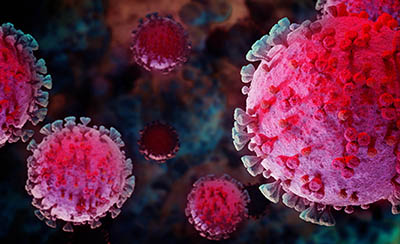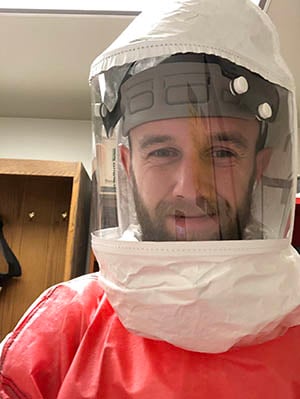
Popular topics

Diary of a Coronavirologist

A cluster of pneumonia cases of unknown cause were detected in Wuhan City, Hubei Province, China, in December 2019. By early January 2020, authorities in China had identified a novel coronavirus as the cause. The World Health Organization declared this coronavirus outbreak a pandemic in March 2020, after thousands of infections occurred all over the globe.
Stuart Weston, a post-doctoral researcher at the University of Maryland School of Medicine, USA, who is working on coronaviruses and influenza shares his insights on what it is like to be a coronavirologist during the 2020 SARS-CoV2 (COVID-19) pandemic in this guest blog.
 A big heavy door with yellow biohazard warning labels stands in front of me. Insert the key, type in your personal passcode, and walk into the small slightly disorganized anteroom. Various parts of personal protective equipment (PPE) are hanging on hooks and sitting on shelves. There have been months of training that started with just practicing how to put on the PPE under the expert supervision of a senior colleague and watching them in the containment lab. That moved on to actually handling things, but, again, under a watchful eye. The final stage is doing things yourself, without being constantly watched, but requiring someone to be in the room with you. Finally, you’re allowed to do work by yourself, unwatched, you’re free to enter the containment lab alone and unsupervised.
A big heavy door with yellow biohazard warning labels stands in front of me. Insert the key, type in your personal passcode, and walk into the small slightly disorganized anteroom. Various parts of personal protective equipment (PPE) are hanging on hooks and sitting on shelves. There have been months of training that started with just practicing how to put on the PPE under the expert supervision of a senior colleague and watching them in the containment lab. That moved on to actually handling things, but, again, under a watchful eye. The final stage is doing things yourself, without being constantly watched, but requiring someone to be in the room with you. Finally, you’re allowed to do work by yourself, unwatched, you’re free to enter the containment lab alone and unsupervised.
And it’s fine, by this stage, you’ve worked out your routine - for me: change into the scrubs and slip on the horrible Crocs, grab some standard lab gloves, put on the Tyvek suit (essentially a big white onesie), grab the PAPR (powered air-purifying respirator), put in a battery, and turn it on. While the PAPR gets going, put on the booties to cover those horrible Crocs, check that enough air is coming out of the PARP, attach the hood and visor to the airflow and slip it over your head. Now, nicely contained in a purified air environment, put on the outer layers of a big apron and another pair of gloves. You’re all covered and safe, and ready to enter the main room, but obviously there’s a swipe card and of course you left the ID card in the pocket of your jeans. So, grab the card, swipe it against the reader to unlock the door and walk-in.
A whole new room awaits on the other side. A room that’s constantly under negative airflow such that opening the door sucks air in from the anteroom, nothing can come out. In there are the standard biosafety cabinets you’d find in cell culture labs, along with a fridge-freezer, a -80°C freezer, a mouse rack and various other things found in your average lab. But, within this lab are viruses that can kill a lot of people. Hence why you need to be all covered in the PPE, breathing purified air, in a room under negative pressure. There are tubes of liquid that could kill somewhere between 10 and 35% of infected people if they got free. You have to be careful. By the time a tube of virus gets opened, there are three levels of protection between it, you, and the outside world: the biosafety cabinet, the negative airflow of the room, and your PPE. You’ve gone through all the training to be in the biosafety level 3 lab (BSL3) and had all the other scientific training beforehand, so handling these viruses is no issue and you know you are actually safer from viral disease in this room than out in the real world. Despite all of this, it’s still pretty strange.
The time comes when you finish the experiments you needed to do with these containment level viruses, and you need to get out. So, grab that spray bottle of 70% ethanol and spray it all over. Soak the apron, the outer pair of gloves, the booties and take off those outer layers and throw them in the trash to be autoclaved out at a later point. Then just spray ethanol everywhere once again, cover the Tyvek suit, cover those horrible Crocs, cover your gloves and your hood and visor, make sure you’ve basically had a shower in ethanol and then you can leave. Not that there would be virus on you, because you’re careful about how you work, but ethanol kills these viruses pretty quickly.
But, while it’s all fine and nothing to stress over, it’s still a pain to spend 10 minutes putting on, and another 10 taking off, the PPE just so you can do an experiment. The conversation between post-doc and boss started to be, “can we try and move away from these silly coronaviruses that no-one really cares about and focus on influenza” (a virus that isn’t high containment).
The year is 2019.
We did start to try and move away from coronaviruses, but then 2020 came around. New Year, new you… or more specifically new lab focus. In the first few weeks of January, reports started to emerge from China that a new coronavirus was infecting people in Wuhan. At one point there were around 40 cases and the conversation in the lab became, “let’s not jump on this, people will, but it won’t be anything big, surely...?”. A day that’s personally vividly stuck in my memory is a walk around a trail in Baltimore on the second weekend of January telling someone the history of the SARS-CoV outbreak of 2003. The story was ended by saying that there’s now a new coronavirus that seems to be infecting people in China, but it “probably won’t be anything serious, just kind of cool to see coronaviruses in the news”. My early predictions were pretty bad.
Since then more and more cases of human disease were seen in China, and soon enough cases outside of China were reported. Within a remarkably short space of time, the virus was originally known as the novel coronavirus 2019 (nCoV-2019), now SARS-CoV-2, went to a global epidemic and now a pandemic. The conversation in the lab rapidly shifted from, “we aren’t going to jump on this right?” to “how soon can we get a hold of this”, and now to “how soon can we test that drug and vaccine candidate”.
Coronaviruses weren’t really in the minds of most people. There are now 7 human coronaviruses, 4 of them are responsible for the common cold every winter (up to about 25% of colds are from coronaviruses). Maybe you will remember SARS or have heard of MERS.
Now I can’t spend an afternoon with friends (in the rare moments outside of the lab) without having questions fired at me about what’s going on, or overhear strangers talk about “the coronavirus” and wonder if I should chime in (I do love talking about this and I do love that those friends are curious). Now the fact that I had to go through 20 visits into the BSL3 under the watchful eye of a senior colleague to make sure I could do it properly starts to make sense. Now the fact that I’ve been trained to safely work with viruses that are responsible for serious disease makes sense. Now the fact I spend time with viruses that people didn’t care about makes sense. (Now everyone knows how much I hate wearing Crocs). Now I’m here, I hope I can do something beneficial.
Stuart.
How Close Are We to a Vaccine?
There is a huge global effort to try and develop a vaccine for SARS-CoV-2 to prevent infection or treat those infected. Many academic institutions and companies are fast-tracking research to create vaccine candidates that are suitable for clinical trials, while other researchers, like Stuart, are studying SARS-CoV2 to try and better understand viral pathogenesis. The first human trial of a vaccine has already started - although it will still be some time until the results are known. Other vaccines are hoping to begin clinical trials by summer 2020, so it is possible that a vaccine that will help end the pandemic is just on the horizon.
You may also be interested in...

View more Guest Blog or Careers blogs















